Aquitaine
 The name Aquitaine has its origin in Roman times. They called the area Aquitania. The inhabitants were called Aquitani. They were different from the Gauls by language and laws. Emperor Augustus seperated Gaul into 3 provinces. The area between Loire and the Pyrenees was called Aquitainia.
The name Aquitaine has its origin in Roman times. They called the area Aquitania. The inhabitants were called Aquitani. They were different from the Gauls by language and laws. Emperor Augustus seperated Gaul into 3 provinces. The area between Loire and the Pyrenees was called Aquitainia. This part of south west France is divided into five departments: Gironde, Les Landes, Dordogne, Pyréneés Atlantiques (Frans Baskenland) and Lot-et-Garonne. These areas are quite different from one another. Especially on the old pilgrim route to Santiago de Compostela there are beautiful historical buildings.
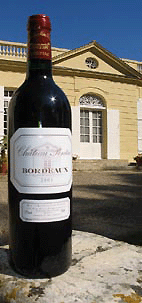 The area around Bordeaux is known for its famous wines. There are many wine chateaus where you can taste to your heart's content. The coastal strip between the delta of the Gironne river and Bayonne is called the Côte d'Argent, the silver coast. Here you can find miles of beaches with walking dunes and a silver sea. On the Côte d'Argent are several seaside towns such as Soulac-sur-Mèr, Lacanau-Océan, Mimizan-Plage, Hossegor and Capbreton. There are also several salt water lakes and you can also take a boat trip on the Etang de Léon.
The area around Bordeaux is known for its famous wines. There are many wine chateaus where you can taste to your heart's content. The coastal strip between the delta of the Gironne river and Bayonne is called the Côte d'Argent, the silver coast. Here you can find miles of beaches with walking dunes and a silver sea. On the Côte d'Argent are several seaside towns such as Soulac-sur-Mèr, Lacanau-Océan, Mimizan-Plage, Hossegor and Capbreton. There are also several salt water lakes and you can also take a boat trip on the Etang de Léon. The Dordogne has already been discovered by many northern Europeans like the Dutch and English. It is a fertile area with lots of fruit trees. This area of France also has a rich history, as show the many caves with prehistoric art, the many castles and old towns. The Dordogne also has a famous kitchen. Foie Gras (goose and duck liver pate) and black truffles are among the many favourite dishes of the locals. But it is also an area where you can find some needed rest. Natural splendour invites you on long walks, but you can also try some white water rafting on the Dordogne river, which has given its name to the area.
In Les Landes you will find several wonderful beach resorts, enormous woodlands which were created to drain the swamps and the national park, which was created in 1970.
Gironde and Lot-et-Garonne are well known for its bastides and soft landscapes.
The Pyrénées Atlantique is a beautiful area with long beaches and an amazing blue ocean. Here you find the French part of the Land of the Basques, one of the most intriguing parts of France with its very own culture and language. The origin and early history are still a mystery. The Romans called the inhabitants Vascones. The language, Euskara, is the only language in south western Europe which has no Latin influence, it is actually quite unique. Here we also find the most famous seaside town of the Aquitaine, Biarritz.
In short, the south west of France has much to offer. Below we give you a few examples of its many sites.
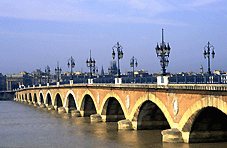 Bordeaux
BordeauxIn Roman times, Burdigala was already a famous port and wine town. It was in fact one of the most important cities in Gaul and capital of the province of Aquitania. The Romans introduced the wine here. In the 4th century, the city became the seat of a bisshop and in the Middle Ages it was loyal to the dukes of Aquitaine at one point in time, and to the dukes of the Gascogne at another. Between 1154 until 1451/1453 it was a province of England. In this period trade flourished and Bordeaux became an economic and cultural centre. The city centre with its streets and squares on the banks of the river Garonne is a beautiful example of 18th century city architecture.
Sites
- The 18th century Grand Théatre located on the busy Place de la Comédie, where the Roman forum used to be.
- The Esplenade des Quinconces from the 19th century, the biggest square in Europe.
- The Jardin Public with its Natural History Museum.
- The Palais Gallien from the 3rd century, the only building that remains from Roman Burdigala. It is the entrance to the old amphitheatre, where 15.000 people could be seated.
- The Church of st. Seurin, built between the 12th and 15th century.
- The Church of St.André, also built between the 12th and 15th century.
- The Tour Pey Berland, built in the 15th century by an arch bisshop with the same name. On the tower you can see the 19th century statue of the Notre-Dame d'Aquitaine.
- The Pont de Pierre, a 19th century bridge over the Garonne river with 17 arches.
On the coast you find the town of Pauillac, where you can visit the Pauillac and Medoc wine information centre. There is also a small wine museum. South of Pauillac are several beautiful wine chateaus, such as the Chateau de Beychevelle.
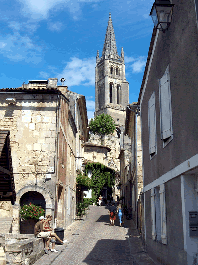 St. Émilion is an old town situated in between the winelands. It dates from the 8th century, when the hermit Émilion made himself a cave in the rocks. After his death a monolithic church was carved from the rocks. Later a monastery was added and in the Middle Ages, a small town and another monastery was built nearby. In St. Émilion are wonderful old medieval buildings. Parts of the 13th century walls are still there. And of course the town is also famous for its wine. You can explore the medieval town centre and taste some wine and have a wonderful day out!
St. Émilion is an old town situated in between the winelands. It dates from the 8th century, when the hermit Émilion made himself a cave in the rocks. After his death a monolithic church was carved from the rocks. Later a monastery was added and in the Middle Ages, a small town and another monastery was built nearby. In St. Émilion are wonderful old medieval buildings. Parts of the 13th century walls are still there. And of course the town is also famous for its wine. You can explore the medieval town centre and taste some wine and have a wonderful day out! The small harbour of Bergerac on the Dordogne river is a commercial centre with shops. Especially tabacco. One of its sites is the tabacco museum. In earlier days it was a prosperous port thanks to the wine trade and today it is an important centre for wine, tabacco and sweetcorn. During the Wars of Religion, the town was damaged badly. A large amount of its population fled to the Americas and England.
The famous hero, Cyrano de Bergerac, who is associated with this town, was a man in love with a big nose, created by Edmond Rostand for his play. The story was inspired by a 17th century man with the same name, who has, unfortunately, nothing to do with Bergerac itself. The town doesn't worrie about this little detail and proudly raised a statue of Cyrano de Bergerac in the centre of the town.
 The caves of Lascaux
The caves of LascauxIn 1940, 4 boys were looking for their runaway dog, when they fell into an opening and discovered the amazing prehistoric paintings. About 17.000 years ago, several Cro-Magnon people made these drawings, which would go into history as the most beautiful example of prehistoric art. Five or six diferent styles of drawing have been discovered, and you can see bisons, horses and mammoths. Also the biggest drawing of a bull of over 5 meters wide can be seen here. In 1948, the cave was opened for the public, but the sweat and breath of its visitors would damage the paintings considerably and the cave was closed in 1963. In 1983, a cave was opened for the public, called Lascaux II. In this cave people can now see an exact replica of the original cave.
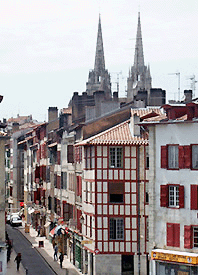 The chocolate town of Bayonne was founded by the Romans and given the name of Lapurdum. Today, together with Biarritz and Anglet, it is a popular urbanisation known as BAB, visited by many tourists each year. In the 17th century, architect Vauban built the impressive citadel, where you can enjoy a splendid walk. In the 13th century, the cathedral Ste-Marie was built. When you are interested in the culture of the Basques, then do visit the Musée Basque et de l'Histoire de Bayonne. Art lovers will enjoy the Musée Bonnat, with paintings of El Greco, Goya, Degas and Rubens.
The chocolate town of Bayonne was founded by the Romans and given the name of Lapurdum. Today, together with Biarritz and Anglet, it is a popular urbanisation known as BAB, visited by many tourists each year. In the 17th century, architect Vauban built the impressive citadel, where you can enjoy a splendid walk. In the 13th century, the cathedral Ste-Marie was built. When you are interested in the culture of the Basques, then do visit the Musée Basque et de l'Histoire de Bayonne. Art lovers will enjoy the Musée Bonnat, with paintings of El Greco, Goya, Degas and Rubens.Between mid June and mid September, you can take boat trips on the river boat Le Bayonne on the Ardour river.
Mid June, a jazz festival is organised called "Jazz sur les Remparts". On the first Wednesday of August, cows are driven through the streets, and there are fireworks, bull fights, Basque music and several other festivities.
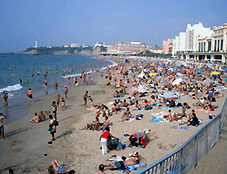 Biarritz used to be very popular among kings and queens of Europe. Nowadays, surfers are attracted to this specific coastal strip.
Biarritz used to be very popular among kings and queens of Europe. Nowadays, surfers are attracted to this specific coastal strip.Also the beautiful golf courses directly on the Atlantic coast are a major attraction. The old fisherman's huts are still there though, leaving a bit of old world charm.
You can visit the Musée Historique de Biarritz in the old Anglican church.
The light house was built in 1834 and is 44 meters high. The climb of 248 steps are rewarded with a wonderful view.
Périgueux
Périgueux has been the capital of the Périgord for a long time. Today, this market town is devided into three parts. The current town centre can be found around the Cathédrale St. Front. Périgueux was founded by the Romans, who had their town centre in the tourist centre called La Cité. They named the town Vesunna. Vesunna was, however, dismantled in the 3rd century, but you can still find the remains of a temple and the huge arena. Because of its position on the famous route to Santiago de Compostela, many pilgrims visited Périgueux. Their presence brought wealth to the area around the cathedral as well as prestige. Therefore, this area became more important than the former centre in the Cité.
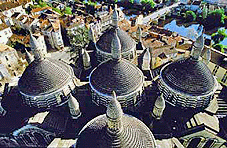 Périgueux has the biggest cathedral of south west France. The towers and domes are from the 19th century, when the church was renovated by the architect Abadie, who became famous for his design of the Sacré-Coeur in Paris. The changes made to the cathedral weren't always encouraged, some even hated the new look, because once it was one of the most beautiful churches in France, inspired by the St. Marcus basilica in Venice. The Byzantine influence is, however, still visible inside. The baroque altar was made out of walnut wood. Maybe you can spot the young dog, who pulls off the sheets of the bed Jesus sleeps in? An unusual and somewhat comical detail for an altarpiece.
Périgueux has the biggest cathedral of south west France. The towers and domes are from the 19th century, when the church was renovated by the architect Abadie, who became famous for his design of the Sacré-Coeur in Paris. The changes made to the cathedral weren't always encouraged, some even hated the new look, because once it was one of the most beautiful churches in France, inspired by the St. Marcus basilica in Venice. The Byzantine influence is, however, still visible inside. The baroque altar was made out of walnut wood. Maybe you can spot the young dog, who pulls off the sheets of the bed Jesus sleeps in? An unusual and somewhat comical detail for an altarpiece.The Musée de Périgord is one of the largest prehistoric museums of France. You can see mosaics and other items from Roman times but also 70.000 year old graves.
About 35 km north east of Périgueux stand the magnificent Chateau de Hautefort.
Chateau de Hautefort with its formal gardens was built in the 17th century and is one of the largest castles of south west France. In 1968 part of the castle burned up in flames, but has now been restored. The chateau is well worth a visit.
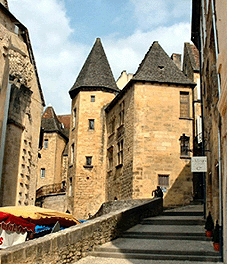 Lovely Sarlat-la-Canéda is the capital of the Black Périgord. The old town or Vieille Ville is a wonderful example of medieval city growth.
Lovely Sarlat-la-Canéda is the capital of the Black Périgord. The old town or Vieille Ville is a wonderful example of medieval city growth.
The prettiest house in town is the Maison de La Boétie, the home of Étienne de La Boétie, friend of Montaigne. The area behind the cathedral, which was rebuilt in the 17th century, has a medieval atmosphere, especially the streets Cour des Fontaines and the Cour des Chanoines.
In the Cour des Chanoines is a 12th century tower, the Lanterne des Morts, of which the exact function is still a mystery. The popular theory is, that it was built in honour of a visit of Saint Bernard of Clairvaux in 1147. During his visit, miracles are supposed to have happened in Sarlat...